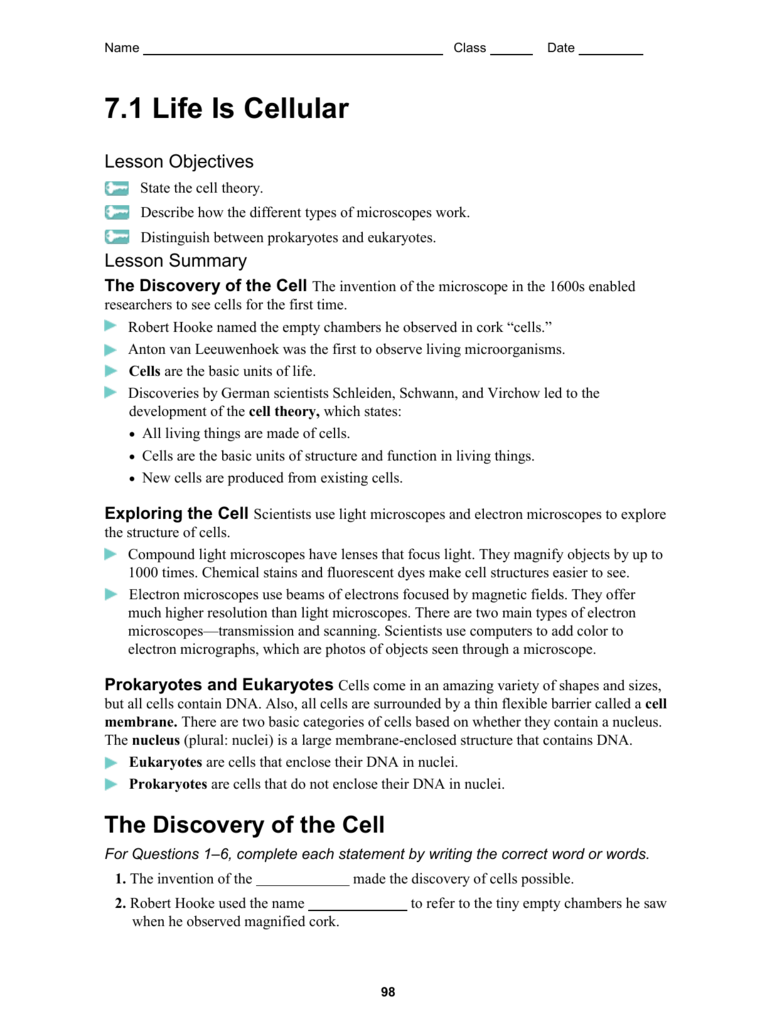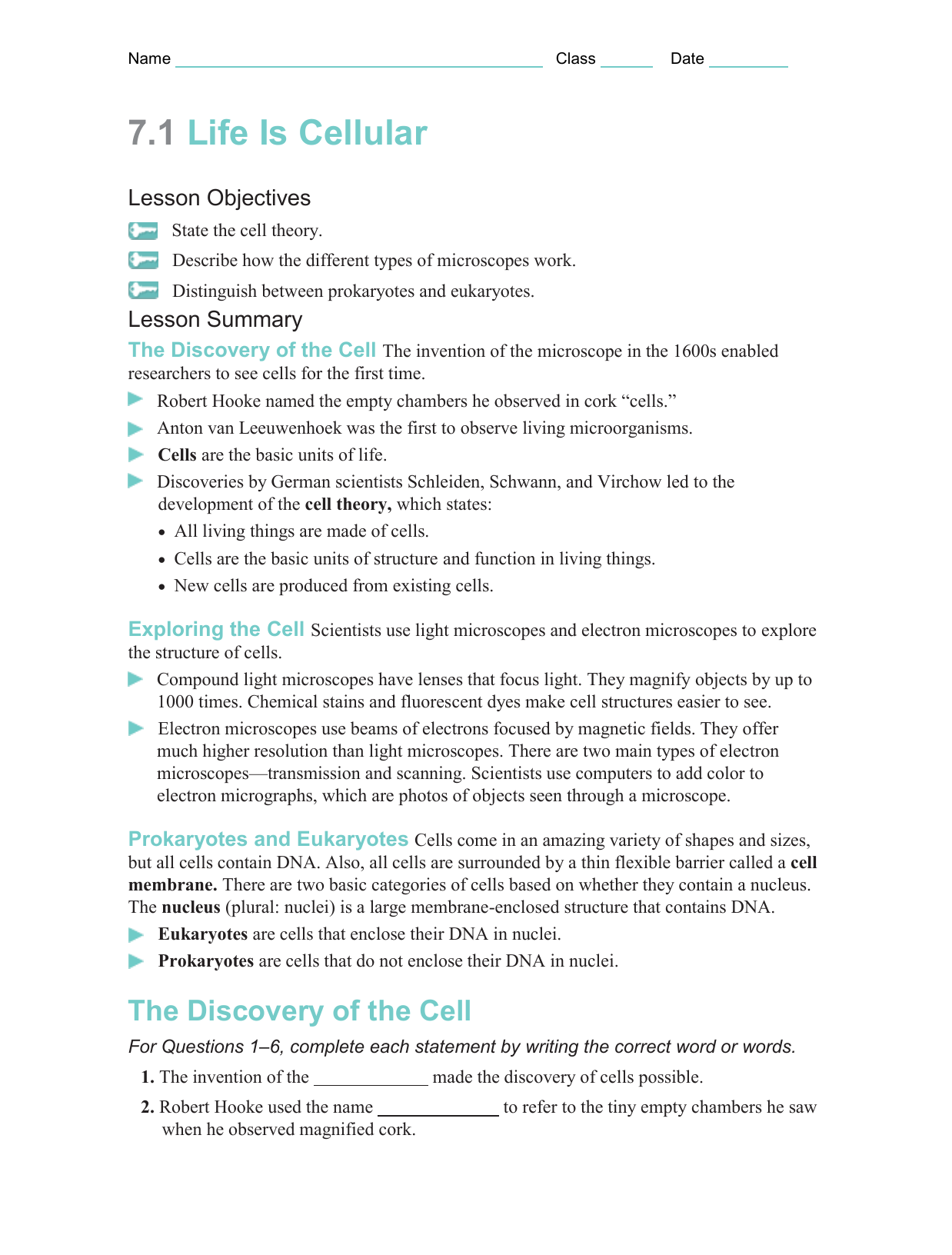7.1 Life Is Cellular - Science Notebook Chapter 7 Answer Key / New cells are produced fromexisting cells 4.
7.1 Life Is Cellular - Science Notebook Chapter 7 Answer Key / New cells are produced fromexisting cells 4.. Using the timeline, place the following in order of their discovery, from the earliest to the latest ____ all plants are made of cells ____ cells organelles. Rudolf virchow (1855, german physician). Robert hooke used the name cells to refer to the tiny empty chambers he saw when he observed magnified cork. In 1665, robert hooke used an early compound microscope to look at a thin slice of cork, a plant material. 4a parts of prokaryotic and eukaryotic cells.
Using the timeline, place the following in order of their discovery, from the earliest to the latest ____ all plants are made of cells ____ cells organelles. All organisms are made of cells. The dna in prokaryotic cells is in the cytoplasm rather than enclosed within a nuclear membrane. • 7.1 life is cellular • 7.2 cell structure • 7.3 cell transport • 7.4 homeostasis and cells 0001_bio10_se_ch07_co.indd 189 6/9/09 1:34:01 pm chapter 7 big ideas: 4 discovery of the cell robert hooke the study of cells is known as cytology.

Without the instruments to make them visible, cells remained out of sight and, therefore, out of mind for most of human history.
Which of the following scientists was the first to observe bacteria? Matthias schleiden (1838, german botanist). Cell structure & function 7.1 life is cellular think about it what?s the smallest part of any living thing that still counts as being ?alive?? Cells come in a variety of shapes and sizes. What is the structure that makes up every living thing? • 7.1 life is cellular • 7.2 cell structure • 7.3 cell transport • 7.4 homeostasis and cells 0001_bio10_se_ch07_co.indd 189 6/9/09 1:34:01 pm chapter 7 big ideas: It explores the founding scientist of cell theory, as well as the details behind the theory and how. Can we just keep dividing living things into smaller and smaller parts, or is there a point at which what?s left is no longer alive? The discovery of the cell was possible due to the invention of the _ 2. Historically, most (descriptive) definitions of life postulated that a living organism must be composed of one or more cells, but this is no longer considered necessary. And that new cells are produced from existing cells. Cellular basis of life and homeostasis 7.1 gq: 4 discovery of the cell robert hooke the study of cells is known as cytology.
It would be hard to find a better example of this than the discovery of the cell. Eukaryotic cells are more complex than prokaryotic cells and have more structures that can take in the stains. 4a parts of prokaryotic and eukaryotic cells. Cell structure & function ms. Cells are the basic unit of structure and function 3.

Cell structure & function 7.1 life is cellular think about it what?s the smallest part of any living thing that still counts as being ?alive??
Hooke leeuwenhoek schleiden schwann virchow 5. Cells are the basic units of life. What are the characteristics of prokaryotes and eukaryotes? And that new cells are produced from existing cells. Using the timeline, place the following in order of their discovery, from the earliest to the latest ____ all plants are made of cells ____ cells organelles. The dna in prokaryotic cells is in the cytoplasm rather than enclosed within a nuclear membrane. Life is cellular i'll think of cells in a jail that are basic unit of life The discovery of the cell was possible due to the invention of the _ 2. That cells are the basic units of structure and function in living things; It would be hard to find a better example of this than the discovery of the cell. Study 6 7.1 life is cellular vocabulary flashcards from unnamed u. The discovery of the cell. Matthias schleiden (1838, german botanist).
Life is cellular i'll think of cells in a jail that are basic unit of life Other scientists' contributions confirmed that cells were the basic units of life. The discovery of the cell seeing is believing, an old saying goes. This lesson introduces that all life is made of cells. 4 discovery of the cell robert hooke the study of cells is known as cytology.

Cytoplasm common cell structures 1.
New cells are produced fromexisting cells 4. This lesson introduces that all life is made of cells. Cells are the basic unit of life. Covering all main ideas, vocabulary, etc. Cells are the basic unit of structure and function 3. 3f history of biology and contributions of scientists; And that new cells are produced from existing cells. Who was the first person to see living creatures under a microscope? Concluded that new cells could be produced only from the division of living cells. Prokaryotic cells are cells without a nucleus. Cell structure & function 7.1 life is cellular think about it what?s the smallest part of any living thing that still counts as being ?alive?? Life is cellular because our planet has living things with cells. • 7.1 life is cellular • 7.2 cell structure • 7.3 cell transport • 7.4 homeostasis and cells 0001_bio10_se_ch07_co.indd 189 6/9/09 1:34:01 pm chapter 7 big ideas:
Komentar
Posting Komentar